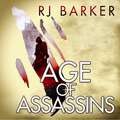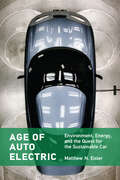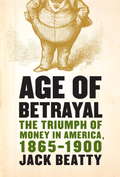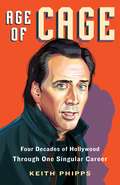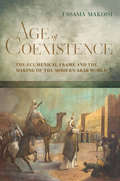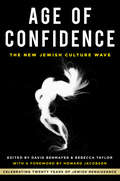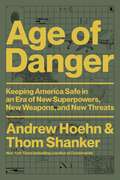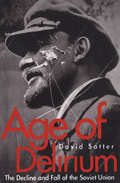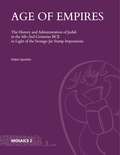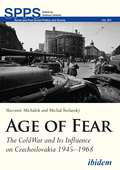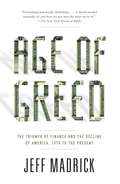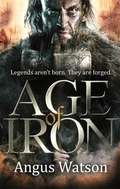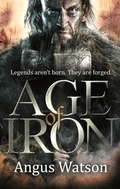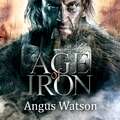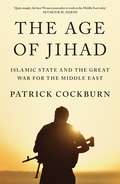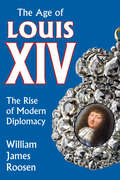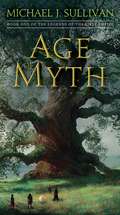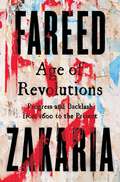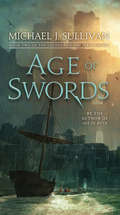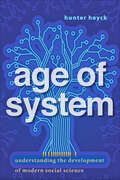- Table View
- List View
Age of Assassins: (The Wounded Kingdom Book 1) To catch an assassin, use an assassin... (The Wounded Kingdom #1)
by RJ Barker***Look out for The Bone Ships, the start of a new fantasy series by RJ Barker!***'Age of Assassins reveals its mysteries with the style of a magic show and the artful grace of a gifted storyteller' Nicholas Eames, author of Kings of the WyldTO CATCH AN ASSASSIN, USE AN ASSASSIN...Girton Club-Foot, apprentice to the land's best assassin, still has much to learn about the art of taking lives. But his latest mission tasks Girton and his master with a far more difficult challenge: to save a life. Someone, or many someones, is trying to kill the heir to the throne, and it is up to Girton and his master to uncover the traitor and prevent the prince's murder. In a kingdom on the brink of civil war and a castle thick with lies Girton finds friends he never expected, responsibilities he never wanted, and a conspiracy that could destroy an entire land.***SHORTLISTED FOR THE DAVID GEMMELL AWARDS 2018******SHORTLISTED FOR THE KITSCHIE AWARDS 2018***'Dead gods, dread magic, and a lead that feels like a breath of fresh air. Great fun' Peter Newman, author of The Vagrant'Outstanding. Beautifully written, perfectly paced and assured. Kept me reading well into the early hours of the morning. A wonderful first book - a wonderful book, period - that should be at the very top of your to-read list' James Islington, author of The Shadow of what was Lost 'Simply unputdownable . . . the perfect mix of fantasy and mystery' Fantasy Book Review 'With an original, immersive world that wouldn't let me go and a pair of assassins worth rooting for, Age of Assassins is a pleasure to read. I can't wait for more!' Melissa Caruso, author of The Tethered Mage 'A dark-humored game of cat and mouse between assassins, with traitors on all sides' David Dalglish, author of the Shadowdance series 'Age of Assassins builds a compelling fantasy world and peoples it with characters you can care about. Riddled with intrigue and dangerous magic, this is a hugely enjoyable debut' Jen Williams, author of The Copper Promise 'Age of Assassins is a beguiling story of action and intrigue combined with a poignancy and humour that are as sharp as any blade' Jon Skovron, author of Hope and Red'Compellingly complex political intrigue and steel-sparking action sequences leavened by warm humour and genuine emotional depth' Chris Brookmyre, author of the Jack Parlabane novelsThe Wounded Kingdom trilogy begins with AGE OF ASSASSINS, continues with BLOOD OF ASSASSINS and will continue with KING OF ASSASSINS.
Age of Auto Electric: Environment, Energy, and the Quest for the Sustainable Car (Transformations: Studies in the History of Science and Technology)
by Matthew N. EislerThe electric vehicle revival reflects negotiations between public policy, which promotes clean, fuel-efficient vehicles, and the auto industry, which promotes high-performance vehicles.Electric cars were once as numerous as internal combustion engine cars before all but vanishing from American roads around World War I. Now, we are in the midst of an electric vehicle revival, and the goal for a sustainable car seems to be within reach. In Age of Auto Electric, Matthew N. Eisler shows that the halting development of the electric car in the intervening decades was a consequence of tensions between environmental, energy, and economic policy imperatives that informed a protracted reappraisal of the automobile system. These factors drove the electric vehicle revival, argues Eisler, hastening automaking&’s transformation into a science-based industry in the process.Challenging the common assumption that the electric vehicle revival is due to the development of better batteries, Age of Auto Electric instead focuses on changing environmental and socioeconomic conditions, energy and environmental policies, systems of energy conversion and industrial production, and innovation practices that affected the prevalence and popularity of electric vehicles in recent decades. Eisler describes a world in transition from legacy to alternative energy-conversion systems and the promises, compromises, new problems, and unintended consequences that enterprise has entailed.
Age of Betrayal: The Triumph Of Money In America, 1865-1900
by Jack BeattyA senior editor at The Atlantic Monthly, Beatty tells how, having redeemed democracy during the Civil War, America betrayed it during the Gilded Age. That time, he says, saw the birth of the plutocracy and inequality that rules the country a century later. Annotation ©2007 Book News, Inc. , Portland, OR (booknews. com)
Age of Cage: Four Decades of Hollywood Through One Singular Career
by Keith Phipps“Age of Cage might be the closest we will get to understanding the singular beauty of each of Nic Cage’s always electric performances. You are holding the Rosetta Stone for Cage. Enjoy it.”—Paul Scheer, actor, writer and host of the How Did This Get Made? and Unspooled podcastsIcon. Celebrity. Artist. Madman. Genius. Nicolas Cage is many things, but love him, or laugh at him, there's no denying two things: you’ve seen one of his many films, and you certainly know his name. But who is he, really, and why has his career endured for over forty years, with more than a hundred films, and birthed a million memes?Age of Cage is a smart, beguiling book about the films of Nicolas Cage and the actor himself, as well as a sharp-eyed examination of the changes that have taken place in Hollywood over the course of his career. Critic and journalist Keith Phipps draws a portrait of the enigmatic icon by looking at—what else?—Cage’s expansive filmography.As Phipps delights in charting Cage’s films, Age of Cage also chronicles the transformation of film, as Cage’s journey takes him through the world of 1980s comedies (Valley Girl, Peggy Sue Got Married, Moonstruck), to the indie films and blockbuster juggernauts of the 1990s (Wild at Heart, Leaving Las Vegas, Face/Off, Con Air), through the wild and unpredictable video-on-demand world of today. Sweeping in scope and intimate in its profile of a fiercely passionate artist, Age of Cage is, like the man himself, surprising, insightful, funny, and one of a kind. So, snap out of it, and enjoy this appreciation of Nicolas Cage, national treasure.
Age of Coexistence: The Ecumenical Frame and the Making of the Modern Arab World
by Ussama MakdisiToday’s headlines paint the Middle East as a collection of war-torn countries and extremist groups consumed by sectarian rage. Ussama Makdisi’s Age of Coexistence reveals a hidden and hopeful story that counters this clichéd portrayal. It shows how a region rich with ethnic and religious diversity created a modern culture of coexistence amid Ottoman reformation, European colonialism, and the emergence of nationalism. Moving from the nineteenth century to the present, this groundbreaking book explores, without denial or equivocation, the politics of pluralism during the Ottoman Empire and in the post-Ottoman Arab world. Rather than judging the Arab world as a place of age-old sectarian animosities, Age of Coexistence describes the forging of a complex system of coexistence, what Makdisi calls the “ecumenical frame.” He argues that new forms of antisectarian politics, and some of the most important examples of Muslim-Christian political collaboration, crystallized to make and define the modern Arab world. Despite massive challenges and setbacks, and despite the persistence of colonialism and authoritarianism, this framework for coexistence has endured for nearly a century. It is a reminder that religious diversity does not automatically lead to sectarianism. Instead, as Makdisi demonstrates, people of different faiths, but not necessarily of different political outlooks, have consistently tried to build modern societies that transcend religious and sectarian differences.
Age of Confidence: Celebrating Twenty Years of Jewish Renaissance
by Howard Jacobson Rebecca Taylor David BenmayerTaking the terrorist attacks of 9/11 as their starting point, five new essays look at how Jewish culture has changed over the past two decades. Covering music (Vanessa Paloma Elbaz), art (Monica Bohm Duchen), literature (Bryan Cheyette), theatre (Judi Herman) and film (Nathan Abrams), the essays explore the role of confidence in the cultural output of minority communities, and ask whether the trends identified look set to continue over the coming years.Commissioned to mark the twentieth anniversary of Jewish Renaissance magazine, the book includes a foreword by Howard Jacobson and is interspersed with a selection of the best articles from the magazine’s archive, including pieces by the director Mike Leigh, author Linda Grant and sociologist Keith Kahn-Harris.
Age of Contradiction: American Thought and Culture in the 1960s
by Howard BrickIn Age of Contradiction, Howard Brick provides a rich context for understanding historical events, cultural tensions, political figures, artistic works, and trends of intellectual life. His lucid and comprehensive book combines the best methods of historical analysis and assessment with fascinating subject matter to create a three-dimensional portrait of a complicated time. In one of the only books on the 1960s to put ideas at the center of the period's history, Brick carefully explores the dilemmas, the promise, and the legacy of American thought in that time.
Age of Danger: Keeping America Safe in an Era of New Superpowers, New Weapons, and New Threats
by Andrew Hoehn Thom ShankerAn urgent look at how America's national security machine went astray and how it fails to keep us safe—and what we can do to fix it. Again and again, American taxpayers are asked to open their wallets and pay for a national security machine that costs $1 trillion operate. Yet time and time again, the US government gets it wrong on critical issues. So what can be done? Enter bestselling author Thom Shanker and defense expert Andrew Hoehn. With decades of national security expertise between them and access to virtually every expert, they look at what&’s going wrong in national security and how to make it go right. Age of Danger looks at the major challenges facing America—from superpowers like Russia and China to emerging threats like pandemics, cybersecurity, climate change, and drones—and reimagines the national security apparatus into something that can truly keep Americans safe. Weaving together expert analysis with exclusive interviews from a new generation of national security leaders, Shanker and Hoehn argue that the United States must create an industrial-grade, life-saving machine out of a system that, for too long, was focused only on deterring adversaries and carrying out global military operations. It is a timely and crucial call to action—a call that if heeded, could save Americans lives, money, and our very future on the global stage.
Age of Delirium: The Decline and Fall of the Soviet Union
by David SatterThe first state in history to be based explicitly on atheism, the Soviet Union endowed itself with the attributes of God. In this book, David Satter shows through individual stories what it meant to construct an entire state on the basis of a false idea, how people were forced to act out this fictitious reality, and the tragic human cost of the Soviet attempt to remake reality by force.“I had almost given up hope that any American could depict the true face of Russia and Soviet rule. In David Satter’s Age of Delirium, the world has received a chronicle of the calvary of the Russian people under communism that will last for generations.†?—Vladimir Voinovich, author of The Life and Extraordinary Adventures of Private Ivan Chonkin“Spellbinding. . . . Gives one a visceral feel for what it was like to be trapped by the communist system.†?—Jack Matlock, Washington Post“Satter deserves our gratitude. . . . He is an astute observer of people, with an eye for essential detail and for human behavior in a universe wholly different from his own experience in America.†?—Walter Laqueur, Wall Street Journal “Every page of this splendid and eloquent and impassioned book reflects an extraordinarily acute understanding of the Soviet system.†?—Jacob Heilbrunn, Washington Times
Age of Empires: The History and Administration of Judah in the 8th–2nd Centuries BCE in Light of the Storage-Jar Stamp Impressions (Mosaics: Studies on Ancient Israel #2)
by Oded LipschitsStorage jars of many shapes and sizes were in widespread use in the ancient world, transporting and storing agricultural products such as wine and oil, crucial to agriculture, economy, trade and subsistence. From the late 8th to the 2nd century BCE, the oval storage jars typical of Judah were often stamped or otherwise marked: in the late 8th and early 7th century BCE with lmlk stamp impressions, later in the 7th century with concentric circle incisions or rosette stamp impressions, in the 6th century, after the fall of Jerusalem, with lion stamp impressions, and in the Persian, Ptolemaic and Seleucid periods (late 6th–late 2nd centuries BCE) with yhwd stamp impressions. At the same time, several ad hoc systems of stamp impressions appeared: "private" stamp impressions were used on the eve of Sennacherib’s campaign, mwṣh stamp impressions after the destruction of Jerusalem, and yršlm impressions after the establishment of the Hasmonean state. While administrative systems that stamped storage jars are known elsewhere in the ancient Near East, the phenomenon in Judah is unparalleled in its scale, variety and continuity, spanning a period of some 600 years without interruption.This is the first attempt to consider the phenomenon as a whole and to develop a unified theory that would explain the function of these stamp impressions and shed new light on the history of Judah during six centuries of subjugation to the empires that ruled the region—as a vassal kingdom in the age of the Assyrian, Egyptian, and Babylonian empires and as a province under successive Babylonian, Persian, Ptolemaic, and Seleucid rule.
Age of Entanglement
by Kris Manjapra"Age of Entanglement "explores patterns of connection linking German and Indian intellectuals from the nineteenth century to the years after the Second World War. Kris Manjapra traces the intersecting ideas and careers of a diverse collection of individuals from South Asia and Central Europe who shared ideas, formed networks, and studied one another's worlds. Moving beyond well-rehearsed critiques of colonialism towards a new critical approach, this study recasts modern intellectual history in terms of the knotted intellectual itineraries of seeming strangers. Collaborations in the sciences, arts, and humanities produced extraordinary meetings of German and Indian minds. Meghnad Saha met Albert Einstein, Stella Kramrisch brought the Bauhaus to Calcutta, and Girindrasekhar Bose began a correspondence with Sigmund Freud. Rabindranath Tagore traveled to Germany to recruit scholars for a new Indian university, and the actor Himanshu Rai hired director Franz Osten to help establish movie studios in Bombay. These interactions, Manjapra argues, evinced shared responses to the cultural and political hegemony of the British empire. Germans and Indians hoped to find in one another the tools needed to disrupt an Anglocentric world order. As Manjapra demonstrates, transnational intellectual encounters are not inherently progressive. From Orientalism and Aryanism to socialism and scientism, German-Indian entanglements were neither necessarily liberal nor conventionally cosmopolitan, often characterized as much by manipulation as by cooperation. "Age of Entanglement "underscores the connections between German and Indian intellectual history, revealing the characteristics of a global age when the distance separating Europe and Asia seemed, temporarily, to disappear.
Age of Fear: Othering and American Identity during World War I
by Zachary SmithFear can be more dangerous than the threats we think loom over us—how Germans and German Americans were perceived as a dangerous enemy during World War I.Although Americans have long celebrated their nation's diversity, they also have consistently harbored suspicions of foreign peoples both at home and abroad. In Age of Fear, Zachary Smith argues that, as World War I grew more menacing and the presumed German threat loomed over the United States, many white "Anglo-Saxon" Americans grew increasingly concerned about the vulnerability of their race, culture, and authority. Consequently, they directed their long-held apprehensions over ethnic and racial pluralism onto their German neighbors and overseas enemies whom they had once greatly admired.Smith examines the often racially tinged, apocalyptic arguments made during the war by politicians, propaganda agencies, the press, novelists, and artists. He also assesses citizens' reactions to these messages and explains how the rise of nationalism in the United States and Europe acted as a catalyst to hierarchical racism. Germans in both the United States and Europe eventually took the form of the proverbial "Other," a dangerous, volatile, and uncivilized people who posed an existential threat to the nation and all that Anglo-Saxon Americans believed themselves to be. Exploring what the Great War meant to a large portion of the white American population while providing a historic precedent for modern-day conceptions of presumably dangerous foreign Others, Age of Fear is a compelling look at how the source of wartime paranoia can be found in deep-seated understandings of racial and millennial progress.
Age of Fear: The Cold War and Its Influence on Czechoslovakia, 1945–1968 (Soviet and Post-Soviet Politics and Society #201)
by Slavomír Michálek Michal ŠtefanskýCzechoslovakia played an important role within the Soviet bloc, yet its history remains underresearched. This monograph blends historical analysis of the superpowers’ foreign policies with an assessment of their impact on Czechoslovakia and its position within the Soviet bloc. The book thereby places Czechoslovakia on the map of Cold War history, i.e. the era of “mutually assured destruction” that lasted almost half a century. <P><P> It provides a lucid introduction to some milestones in international Cold War history in their relation to Czecho-Slovak history. The book’s novel contribution is to explain Czechoslovakia’s domestic situation during the Cold War from the “outside.” Drawing on extensive source materials of Slovak, Czech, American, and Russian provenance, it provides a more comprehensive understanding of postwar Czecho-Slovak history while also contributing to general knowledge about the nature and impact of the Cold War.
Age of Greed: The Triumph of Finance and the Decline of America, 1970 to the Present
by Jeff MadrickA vividly told history of how greed bred America's economic ills over the last forty years, and of the men most responsible for them.As Jeff Madrick makes clear in a narrative at once sweeping, fast-paced, and incisive, the single-minded pursuit of huge personal wealth has been on the rise in the United States since the 1970s, led by a few individuals who have argued that self-interest guides society more effectively than community concerns. These stewards of American capitalism have insisted on the central and essential place of accumulated wealth through the booms, busts, and recessions of the last half century, giving rise to our current woes.In telling the stories of these politicians, economists, and financiers who declared a moral battle for freedom but instead gave rise to an age of greed, Madrick traces the lineage of some of our nation's most pressing economic problems. He begins with Walter Wriston, head of what would become Citicorp, who led the battle against government regulation. He examines the ideas of economist Milton Friedman, who created the plan for an anti-Rooseveltian America; the politically expedient decisions of Richard Nixon that fueled inflation; the philosophy of Alan Greenspan, on whose libertarian ideology a house of cards was built on Wall Street; and the actions of Sandy Weill, who constructed the largest financial institution in the world, which would have gone bankrupt in 2008 without a federal bailout of $45 billion. Significant figures including Ivan Boesky, Michael Milken, Jack Welch, and Ronald Reagan play key roles as well.Intense economic inequity and instability is the story of our age, and Jeff Madrick tells it with style, clarity, and an unerring command of his subject.From the Hardcover edition.
Age of Iron (Iron Age #1)
by Angus WatsonLEGENDS AREN'T BORN. THEY'RE MADE.Dug Sealskinner is a down-on-his-luck mercenary traveling south to join up with King Zadar's army. But he keeps rescuing the wrong people.First Spring, a child he finds scavenging on the battlefield, and then Lowa, one of Zadar's most fearsome warriors, who has vowed revenge on the king for her sister's execution.Now Dug's on the wrong side of the thousands-strong army he hoped to join -- and worse, Zadar has bloodthirsty druid magic on his side. All Dug has is his war hammer, one small child, and one unpredictable, highly-trained warrior with a lust for revenge that might get them all killed . . .
Age of Iron (The Iron Age Trilogy #1)
by Angus WatsonLEGENDS AREN'T BORN. THEY'RE FORGED.Dug Sealskinner is a down-on-his-luck mercenary travelling south to join up with King Zadar's army. But he keeps rescuing the wrong people. First, Spring, a child he finds scavenging on the battlefield, and then Lowa, one of Zadar's most fearsome warriors, who's vowed revenge on the king for her sister's execution. Now Dug's on the wrong side of that thousands-strong army he hoped to join - and worse, Zadar has bloodthirsty druid magic on his side. All Dug has is his war hammer, one rescued child and one unpredictable, highly-trained warrior with a lust for revenge that's going to get them all killed . . . It's a glorious day to die.Look out now for YOU DIE WHEN YOU DIE - first in a new historical fantasy series from Angus Watson.'Watson's tale is gore soaked and profanity laden - full of visceral combat and earthy humor, and laced with subtle magic. The blend of historical accuracy and authorial liberties suggests an old-school sword-and-sorcery epic, though with some modern sensibilities thrown in for good measure!' PUBLISHERS WEEKLY'Would I read the next one? Yes, absolutely. Bring me my hammer, bring my beer, bring it on.' SF CROWSNEST'Watson has created a brilliant and confident debut . . . If you like your fantasy packed with hammer-wielding heroes, bloodthirsty druids, strong female leads, action, intrigue, betrayal, and a brilliantly conceived world then AGE OF IRON is for you.' THE BOOK BEARD'Thoroughly entertaining from the get go . . . I really got a kick out of the AGE OF IRON'THE ELOQUENT PAGEFor more epic action from Angus Watson, check out:West of West TrilogyYou Die When You DieThe Land you Never LeaveWhere Gods Fear to GoThe Iron Age TrilogyAge of IronClash of IronReign of Iron
Age of Iron (The Iron Age Trilogy)
by Angus WatsonLEGENDS AREN'T BORN. THEY'RE MADE. Dug Sealskinner is a down-on-his-luck mercenary travelling south to join up with King Zadar's army. But he keeps rescuing the wrong people. First, Spring, a child he finds scavenging on the battlefield, and then Lowa, one of Zadar's most fearsome warriors, who's vowed revenge on the king for her sister's execution. Now Dug's on the wrong side of that thousands-strong army he hoped to join - and worse, Zadar has bloodthirsty druid magic on his side. All Dug has is his war hammer, one rescued child and one unpredictable, highly-trained warrior with a lust for revenge that's going to get them all killed . . . It's a glorious day to die.
Age of Jihad: Islamic State and the Great War for the Middle East
by Patrick CockburnFrom the award-winning author of The Rise of Islamic State, the essential story of the Middle East's disintegrationThe Age of Jihad charts the turmoil of today's Middle East and the devastating role the West has played in the region from 2001 to the present. Beginning with the US-led invasion of Afghanistan, Cockburn explores the vast geopolitical struggle that is the Sunni-Shia conflict, a clash that shapes the war on terror, western military interventions, the evolution of the insurgency, the civil wars in Yemen, Libya and Syria, the Arab Spring, the fall of regional dictators, and the rise of Islamic State. As Cockburn shows in arresting detail, Islamic State did not explode into existence in Syria in the wake of the Arab Spring, as conventional wisdom would have it. The organization gestated over several years in occupied Iraq, before growing to the point where it can threaten the stability of the whole region. Cockburn was the first Western journalist to warn of the dangers posed by Islamic State. His originality and breadth of vision make The Age of Jihad the most in-depth analysis of the regional crisis in the Middle East to date.From the Hardcover edition.
Age of Louis XIV: The Rise of Modern Diplomacy
by William James RoosenWilliam James Roosen has written the first general study of European diplomacy in the age of Louis XIV which is based on the actual practices and institutions of that era, rather than on the writing of early theoreticians.Though the seventeenth century may not have been a period of great innovations in international diplomacy, it provides us with an important illustration of the "workings of a system which was well suited to the gradually changing needs of its time" and which has been called "the best form of diplomacy ever developed."Dr. Roosen demonstrates both the obvious differences and the many similarities between diplomatic procedures and practices of the seventeenth century and the twentieth. Any student of diplomacy and international relations will gain valuable insight and understanding from this study of the early modern diplomatic personalities, institutions, and practices.One of Dr. Roosen's goals in writing this book has been to discover the relationships between the ideological and socioeconomic structures and the diplomatic personalities who have influenced modern diplomacy. Further, he supplies the only available study of the realities of diplomatic practices in seventeenth century Europe, and provides an excellent basis for comparison with twentieth century international relations, in the hope that "studying early modern diplomatic personalities, institutions and practices should increase our understanding of international relations today."There are chapters on "The States of Europe," "Kings and Ministers," "Ambassadors," "Second Class Diplomats," "A Typical Early Modern Embassy," "Information: Important Objective of Diplomatic Activity," and "The Variety of Diplomatic Duties.
Age of Marshall: Aspects of British Economic Thought
by Narmedeshwar JhaFirst published in 1973. This is the second edition and nine years after when The Age of Marshall was first published. The period 1890-1915 in the history of British Economic Thought may aptly be described as the Age of Marshall. His influence as teacher, and his ideas as presented in the Principles of Economics (1890) and other writings, stimulated and often dominated the ideas and writings of most of the younger economists of the period. His ideas also provided a theoretical basis for increasing state intervention in economic life of the community in Britain and thus helped the Liberal Government of Great Britain lay the foundations of a Welfare State.
Age of Myth: Book One of The Legends of the First Empire (The Legends of the First Empire #1)
by Michael J. SullivanMichael J. Sullivan's trailblazing career began with the breakout success of his Riyria series: full-bodied, spellbinding fantasy adventures whose imaginative scope and sympathetic characters won a devoted readership and comparisons to fantasy masters Brandon Sanderson, Scott Lynch, and J.R.R. Tolkien himself. Now Sullivan's stunning hardcover debut, Age of Myth, inaugurates an original five-book series--and one of fantasy's finest next-generation storytellers continues to break new ground. Since time immemorial, humans have worshipped the gods they call Fhrey, truly a race apart: invincible in battle, masters of magic, and seemingly immortal. But when a god falls to a human blade, the balance of power between humans and those they thought were gods changes forever. Now only a few stand between humankind and annihilation: Raithe, reluctant to embrace his destiny as the God Killer; Suri, a young seer burdened by signs of impending doom; and Persephone, who must overcome personal tragedy to lead her people. The Age of Myth is over. The time of rebellion has begun.Praise for Michael J. Sullivan "Hair-raising escapes, flashy sword fights, and faithful friendship complete the formula for good old-fashioned escapist fun."--Publishers Weekly, on Theft of Swords "Filled with adventure and clever dialog and featuring a pair of not-quite-heroes whose loyalties to each other provide them with their greatest strength, this epic fantasy showcases the arrival of a master storyteller."--Library Journal, on Theft of Swords "With less gore and a smaller cast of characters than George R. R. Martin's Song of Ice and Fire but equally satisfying, Sullivan's epic fantasy will be gaining fans at exponential rates."--Library Journal, on The Rose and the ThornFrom the Hardcover edition.
Age of Revolutions: Progress and Backlash from 1600 to the Present
by Fareed ZakariaThe CNN host and best-selling author explores the revolutions—past and present—that define the polarized and unstable age in which we live. <p><p> Populist rage, ideological fracture, economic and technological shocks, war, and an international system studded with catastrophic risk—the early decades of the twenty-first century may be the most revolutionary period in modern history. But it is not the first. Humans have lived, and thrived, through more than one great realignment. What are these revolutions, and how can they help us to understand our fraught world? <p><p> In this major work, Fareed Zakaria masterfully investigates the eras and movements that have shaken norms while shaping the modern world. Three such periods hold profound lessons for today. First, in the seventeenth-century Netherlands, a fascinating series of transformations made that tiny land the richest in the world—and created politics as we know it today. Next, the French Revolution, an explosive era that devoured its ideological children and left a bloody legacy that haunts us today. Finally, the mother of all revolutions, the Industrial Revolution, which catapulted Great Britain and the US to global dominance and created the modern world. <p><p> Alongside these paradigm-shifting historical events, Zakaria probes four present-day revolutions: globalization, technology, identity, and geopolitics. For all their benefits, the globalization and technology revolutions have produced profound disruptions and pervasive anxiety and our identity. And increasingly, identity is the battlefield on which the twenty-first century’s polarized politics are fought. All this is set against a geopolitical revolution as great as the one that catapulted the United States to world power in the late nineteenth century. Now we are entering a world in which the US is no longer the dominant power. As we find ourselves at the nexus of four seismic revolutions, we can easily imagine a dark future. But Zakaria proves that pessimism is premature. If we act wisely, the liberal international order can be revived and populism relegated to the ash heap of history. <p><p> As few public intellectuals can, Zakaria combines intellectual range, deep historical insight, and uncanny prescience to once again reframe and illuminate our turbulent present. His bold, compelling arguments make this book essential reading in our age of revolutions. <p> <b>New York Times Bestseller</b>
Age of Swords: Book Two of The Legends of the First Empire
by Michael J. SullivanThe gods have been proven mortal and new heroes will arise as the battle continues in the sequel to Age of Myth—from the author of the Riyria Revelations and Riyria Chronicles series.In Age of Myth, fantasy master Michael J. Sullivan launched readers on an epic journey of magic and adventure, heroism and betrayal, love and loss. Now the thrilling saga continues as the human uprising is threatened by powerful enemies from without—and bitter rivalries from within. Raithe, the God Killer, may have started the rebellion by killing a Fhrey, but long-standing enmities dividing the Rhunes make it all but impossible to unite against the common foe. And even if the clans can join forces, how will they defeat an enemy whose magical prowess renders them indistinguishable from gods? The answer lies across the sea in a faraway land populated by a reclusive and dour race who feel nothing but disdain for both Fhrey and mankind. With time running out, Persephone leads the gifted young seer Suri, the Fhrey sorceress Arion, and a small band of misfits in a desperate search for aid—a quest that will take them into the darkest depths of Elan. There, an ancient adversary waits, as fearsome as it is deadly.Don’t miss any of Michael J. Sullivan’s Legends of the First Empire novels: AGE OF MYTH | AGE OF SWORDS (Coming soon!) Praise for Michael J. Sullivan “If you enjoy epic fantasy, and are perhaps hungering for something with timeless appeal, then I highly recommend picking up Age of Myth.”—The BiblioSanctum, on Age of Myth “Hair-raising escapes, flashy sword fights, and faithful friendship complete the formula for good old-fashioned escapist fun.”—Publishers Weekly, on Theft of Swords “Filled with adventure and clever dialog and featuring a pair of not-quite-heroes whose loyalties to each other provide them with their greatest strength, this epic fantasy showcases the arrival of a master storyteller.”—Library Journal, on Theft of Swords “With less gore and a smaller cast of characters than George R. R. Martin’s Song of Ice and Fire but equally satisfying, Sullivan’s epic fantasy will be gaining fans at exponential rates.”—Library Journal, on The Rose and the Thorn
Age of System: Understanding the Development of Modern Social Science
by Hunter HeyckIn the years after World War II, a new generation of scholars redefined the central concepts and practices of social science in America.Before the Second World War, social scientists struggled to define and defend their disciplines. After the war, "high modern" social scientists harnessed new resources in a quest to create a unified understanding of human behavior—and to remake the world in the image of their new model man.In Age of System, Hunter Heyck explains why social scientists—shaped by encounters with the ongoing "organizational revolution" and its revolutionary technologies of communication and control—embraced a new and extremely influential perspective on science and nature, one that conceived of all things in terms of system, structure, function, organization, and process. He also explores how this emerging unified theory of human behavior implied a troubling similarity between humans and machines, with freighted implications for individual liberty and self-direction. These social scientists trained a generation of decision-makers in schools of business and public administration, wrote the basic textbooks from which millions learned how the economy, society, polity, culture, and even the mind worked, and drafted the position papers, books, and articles that helped set the terms of public discourse in a new era of mass media, think tanks, and issue networks. Drawing on close readings of key texts and a broad survey of more than 1,800 journal articles, Heyck follows the dollars—and the dreams—of a generation of scholars that believed in "the system." He maps the broad landscape of changes in the social sciences, focusing especially intently on the ideas and practices associated with modernization theory, rational choice theory, and modeling. A highly accomplished historian, Heyck relays this complicated story with unusual clarity.
Age of War: Book Three Of The Legends Of The First Empire (The Legends of the First Empire #3)
by Michael J. SullivanThe epic battle between humankind and their godlike rulers finally ignites in the masterful follow-up to Age of Myth and Age of Swords. The alliance of humans and renegade Fhrey is fragile—and about to be tested as never before. Persephone keeps the human clans from turning on one another through her iron will and a compassionate heart. The arrogant Fhrey are barely held in check by their leader, Nyphron, who seeks to advance his own nefarious agenda through a loveless marriage that will result in the betrayal of the person Persephone loves most: Raithe, the God Killer. As the Fhrey overlords marshal their army and sorcerers to crush the rebellion, old loyalties will be challenged while fresh conspiracies will threaten to undo all that Persephone has accomplished. In the darkest hour, when hope is all but lost, new heroes will rise . . . but at what terrible cost?Magic, fantasy, and mythology collide in Michael J. Sullivan’s Legends of the First Empire series:AGE OF MYTH • AGE OF SWORDS • AGE OF WAR
